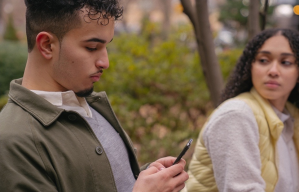I am the most indecisive person I know. I spend hours surveying every aisle at the grocery store, deciding whether I should buy this item or that one. The same goes for when I’m shopping for new clothes or picking out new decorations for my apartment. Oh, I like that. Oh wait, I think I like that one better. When I’m invited to go to dinner or to see a movie, I spend at least a couple of days rolling the idea over in my mind. Do I want to go? Or would I rather stay home? And the only reason it doesn’t take me more than an hour to order (when I actually say yes to dinner) is because I’m also the pickiest eater you’ll ever meet. But that’s a story for another day. Now, being this indecisive can certainly pose some serious problems. I mean, imagine my terror when faced with a major decision, like moving or breaking up with a boyfriend. It’s a tough life. And after living this way for 20+ years, I began to wonder, what’s the psychology behind it? This led me to the discovery of ambivalence.
While my hesitation at the grocery store or at a restaurant is easily explained by indecisiveness–or the inability to make decisions quickly—my being torn in more serious aspects of my life may be described as ambivalence. Ambivalence is the state of having conflicting feelings or ideas about something or someone. It’s what you experience when deciding whether to leave your girlfriend or not, whom you love but just don’t get along with anymore. It’s what you feel when deciding if you should quit your job, which has really helped you hone your skills but has no further growth potential. Each choice has its drawbacks, its benefits, its limitations, making it difficult and sometimes impossible to make a decision. And the ambivalence behind this indecision is often exhausting, troubling, and upsetting.
Most everybody experiences ambivalence at some point in their lives. We’re human: we have conflicting emotions, perceptions, ideas, desires. And sometimes they get in each other’s way, as we can’t always fulfill and prioritize them simultaneously. But that’s okay—it’s okay to be torn between two big decisions that result in totally different outcomes. Just do yourself a favor and figure out how to better handle ambivalence and its stresses:
- Stay clam. You won’t do yourself any favors by freaking out. But remaining calm will allow you to better evaluate the situation at hand and help you make the right decision.
- Reassure yourself. Whatever happens, it’s not the end of the world. Both outcomes had benefits, otherwise you wouldn’t have been so torn in the first place. So remind yourself that either way, everything will be okay.
- Go with your gut. Ultimately, it all comes down to following your heart and going with your gut. So, look within yourself–the answer might have been there all along.
- Go with all your heart. Once you do make a decision, own it. Reap the benefits, accept the drawbacks, and just go with it. On the contrary, getting caught up in the downsides of your decision will only make you feel regret or waste time wondering if you should have taken the other route.
Ambivalence in Relationships
Love and affection are two needs that humans seek to fulfill. These needs drive our love-crazy attitudes and pursuits of one another, but can also end in relationships filled with ambivalence. This ambivalence develops when opposing emotions and desires emerge, regarding someone’s significant other, which creates the individual’s uncertainty about being in said relationship.
All relationships have conflict. And what is conflict driven by? Opposing desires, opposing views. Sometimes we can easily work through these differences, like compromising on what movie to watch tonight. But at others, it’s extremely difficult or impossible to resolve a conflict, especially when there’s a lot at stake—the very nature of ambivalence. The ultimate manifestation of ambivalence in relationships occurs when the very relationship is in question. Typically, one individual realizes they might not want to be with the other person anymore. And the other individual continues to express their desire to stay in the relationship. So the couple is in a sort of limbo, their actions driven by this conflict, which creates an ambivalent tension.
How much easier life and love would be if we simply said, “yes” or “no” instead of the dreaded “maybe” or sometime worse, “I don’t know.” But we don’t. We’re indecisive and ambiguous and in turn face the wrath of ambivalence which tugs on the seams that keep our relationships and lives together. Moving forward, just realize it’s completely normal to be hesitant about making simple, as well as life-changing decisions. It’s a sign that you’re human and functioning just the way you’re supposed to.












